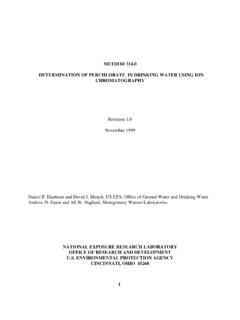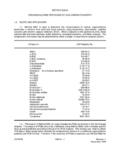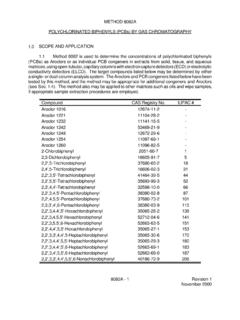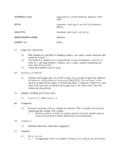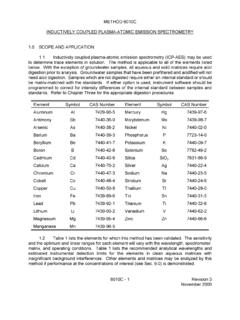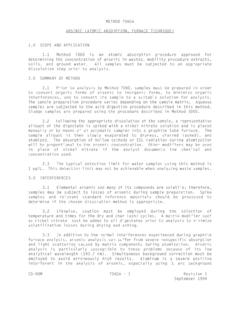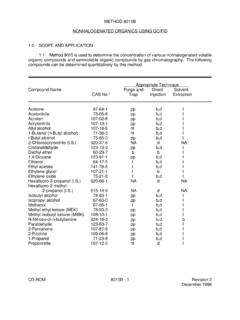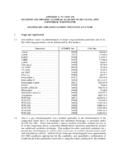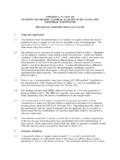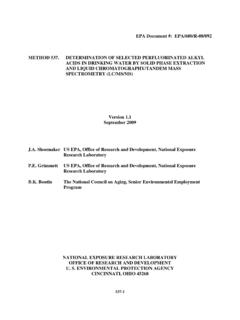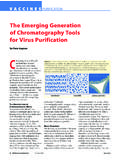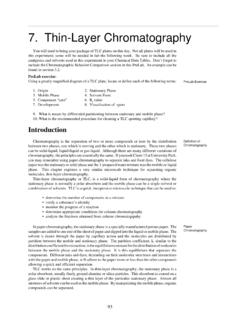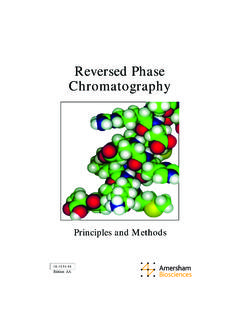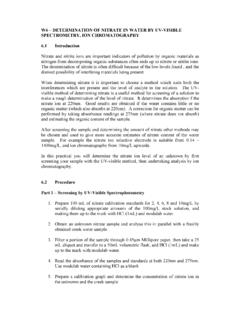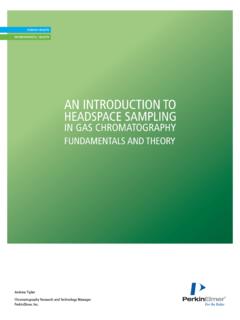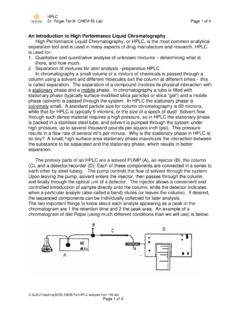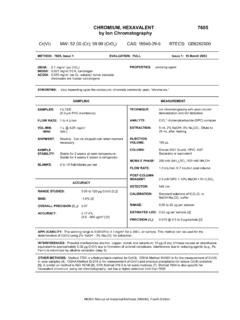Transcription of METHOD 317.0 DETERMINATION OF INORGANIC …
1 - 1 METHOD DETERMINATION OF INORGANIC oxyhalide disinfection BY-PRODUCTS IN DRINKING WATER USING ION chromatography WITH THE ADDITIONOF A POSTCOLUMN REAGENT FOR TRACE BROMATE ANALYSISR evision 2000 Herbert P. Wagner and Barry V. Pepich, IT CorporationDaniel P. Hautman and David J. Munch, US EPA, Office of Ground Water and Drinking WaterNATIONAL EXPOSURE RESEARCH LABORATORYOFFICE OF RESEARCH AND ENVIRONMENTAL PROTECTION AGENCYCINCINNATI, OHIO - 2 METHOD DETERMINATION OF INORGANIC oxyhalide disinfection BY-PRODUCTS IN DRINKING WATER USING ION chromatography WITH THE ADDITIONOF A POSTCOLUMN REAGENT FOR TRACE BROMATE ANALYSIS AND APPLICATION METHOD covers the DETERMINATION of INORGANIC oxyhalide disinfection by-productanions in reagent water, surface water, ground water, and finished drinking water. Inaddition, bromide can be accurately determined in source or raw water and it has beenincluded due to its critical role as a disinfection by-product precursor.
2 Bromideconcentration in finished water can differ significantly between preserved andunpreserved samples and should not be attempted due to numerous variables which caninfluence the concentration. Since this METHOD , prior to the addition of the postcolumnreagent (PCR), employs the same hardware as EPA METHOD , the analysis of thecommon anions (using EPA METHOD , Part A1) can be performed using thisinstrument setup with the postcolumn hardware attached but off-line and with theappropriate smaller sample loop. INORGANIC disinfection By-products by Conductivity DetectionBromate (report values > ug/L)ChloriteBromide(source or raw water only)ChlorateInorganic disinfection By-product by Postcolumn UV/VIS Absorbance DetectionBromate (report values > Minimum Reporting Limit (MRL) to ug/L) single laboratory reagent water METHOD Detection Limits (MDL, defined in ) for the above analytes are listed in Table 1.
3 The MDL for a specific matrix maydiffer from those listed, depending upon the nature of the sample and the specificinstrumentation employed. order to achieve comparable detection limits on the conductivity detector, anion chromatographic system must utilize suppressed conductivity detection, beproperly maintained and must be capable of yielding a baseline with no morethan 5 nanosiemen (nS) noise/drift per minute of monitored response over thebackground conductivity. order to achieve acceptable detection limits on the postcolumn absorbancedetector, the postcolumn reagent must be delivered pneumatically and someform of software signal filtering or smoothing of the absorbance signal from theabsorbance detector must be - METHOD is recommended for use only by or under the supervision of analystsexperienced in the use of ion chromatography and in the interpretation of the resultingion chromatograms.
4 This METHOD is used to analyze unfamiliar samples for any of the above anions,anion identification should be supported by the use of a fortified sample matrixcovering the anions of interest. The fortification procedure is described in of the METHOD data should state the data quality objectives prior to analysis. Users of the METHOD must demonstrate the ability to generate acceptable results withthis METHOD , using the procedures described in Section OF METHOD volume of sample, approximately 225 uL (see Note), is introduced into an ionchromatograph (IC). The anions of interest are separated and measured, using a systemcomprised of a guard column, analytical column, suppressor device, conductivitydetector, a postcolumn reagent delivery system (pneumatically controlled), a heatedpostcolumn reaction coil, and a ultraviolet/visible (UV/VIS) absorbance ,3 NOTE:A 225 uL sample loop can be made using approximately 111 cm (44 inches)of inch PEEK tubing.
5 Larger injection loops may be The volume should be verified to be within 5% by weighing the sample loopempty, filling the loop with deionized water and re-weighing the loopassuming the density of water is 1 mg/uL. BATCH A sequence of samples, which are analyzed within a 30 hourperiod and include no more than 20 field samples. An analysis batch must also includeall required QC samples, which do not contribute to the maximum field sample total of20. The required QC samples include: Laboratory Reagent Blank (LRB) Initial Calibration Check Standard (ICCS) Laboratory Fortified Blank (LFB) Continuing Calibration Check Standard (CCCS), when the batch contains more than10 field samples End Calibration Check Standard (ECCS) Laboratory Fortified Matrix (LFM) Either a Field Duplicate (FD), a Laboratory Duplicate (LD) or a duplicate of the STANDARD (CAL) A solution prepared from the primary dilutionstandard solution(s) or stock standard solutions and the surrogate analyte.
6 The - 4solutions are used to calibrate the instrument response with respect to analyteconcentration. CALIBRATION STANDARDS A series of CAL solutions (eitherindividual or combined target analytes) used to initially establish instrument calibrationand develop calibration curves for individual target anions (Section ). CALIBRATION CHECK STANDARD (ICCS) A CAL solution, (eitherindividual or combined target analytes) which is analyzed initially, prior to any fieldsample analyses, which verifies previously established calibration curves. Theconcentration for the initial calibration check standard MUST be at or below the MRL(Section ) level which is also the level of the lowest calibration standard ( ). CALIBRATION CHECK STANDARDS (CCCS) A CAL solution(either individual or combined target analytes) which is analyzed after every tenth fieldsample analyses which verifies the previously established calibration curves andconfirms accurate analyte quantitation for the previous ten field samples analyzed.
7 Theconcentration for the continuing calibration check standards should be either at amiddle calibration level or at the highest calibration level (Section ). CALIBRATION CHECK STANDARD (ECCS) A CAL solution (eitherindividual or combined target analytes) which is analyzed after the last field sampleanalysis which verifies the previously established calibration curves and confirmsaccurate analyte quantitation for all field samples analyzed since the last continuingcalibration check. The end calibration check standard should be either the middle orhigh level continuing calibration check standard (Section ). DUPLICATES (FD) Two separate field samples collected at the same timeand place under identical circumstances and handled exactly the same throughout fieldand laboratory procedures. Analyses of field duplicates indicate the precisionassociated with sample collection, preservation and storage, as well as with laboratoryprocedures.
8 PERFORMANCE CHECK SOLUTION (IPC) A solution of one ormore METHOD analytes, surrogates, or other test substances used to evaluate theperformance of the instrument system with respect to a defined set of DUPLICATE (LD) Two sample aliquots, taken in the laboratoryfrom a single field sample bottle, and analyzed separately with identical procedures. Analysis of the initial sample (IC) and the duplicate sample [(DC) Section ]indicate precision associated specifically with the laboratory procedures by removingvariation contributed from sample collection, preservation and storage - FORTIFIED BLANK (LFB) An aliquot of reagent water or otherblank matrix to which known quantities of the METHOD analytes are added in thelaboratory. The LFB is analyzed exactly like a sample, and its purpose is to determinewhether the methodology is in control, and whether the laboratory is capable of makingaccurate and precise FORTIFIED SAMPLE MATRIX (LFM) An aliquot of anenvironmental field sample to which known quantities of the METHOD analytes are addedin the laboratory.
9 The LFM is analyzed exactly like a sample, and its purpose is todetermine whether the field sample matrix contributes bias to the analytical result. Thebackground concentrations of the analytes in the field sample matrix must bedetermined in a separate, unfortified aliquot and the measured values in the LFMcorrected for background REAGENT BLANK (LRB) An aliquot of reagent water or otherblank matrix that is handled exactly as a sample including exposure to all glassware,equipment, solvents, reagents, and surrogates that are used with other samples. TheLRB is used to determine if METHOD analytes or other interferences are present in thelaboratory environment, the reagents, or the SAFETY DATA SHEET (MSDS) Written information provided byvendors concerning a chemical's toxicity, health hazards, physical properties, fire, andreactivity data including storage, spill, and handling DETECTION LIMIT (MDL) The minimum concentration of an analytethat can be identified, measured and reported with 99% confidence that the analyteconcentration is greater than REPORTING LEVEL (MRL) The minimum concentration that can bereported as a quantitated value for a target analyte in a sample following analysis.
10 Thisdefined concentration can be no lower than the concentration of the lowest calibrationstandard and can only be used if acceptable quality control criteria for the ICCS are TESTING (PT) or PERFORMANCE EVALUATION (PE) SAMPLE A certified solution of METHOD analytes whose concentration is unknown to theanalyst. Frequently, an aliquot of this solution is added to a known volume of reagentwater and analyzed with procedures used for samples. Often, results of these analysesare used as part of a laboratory certification program to objectively determine thecapabilities of a laboratory to achieve high quality CONTROL SAMPLE (QCS) A solution of METHOD analytes of knownconcentrations that is obtained from a source external to the laboratory and differentfrom the source of calibration standards. It is used to check laboratory performancewith externally prepared test - ANALYTE An analyte added to all samples, standards, blanks, etc.
